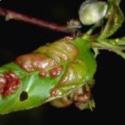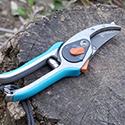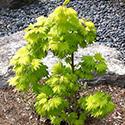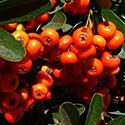What's Hot Archive 2018
What's Hot in January

Winter and early spring are the best times to plant bare root trees. If the planting area is too dry, water thoroughly a few days prior to planting, but do not plant in wet or saturated soil.
Which of the following planting rules are false?
- Dig the planting hole at least twice as wide as the spread of the tree’s roots, digging just deep enough to remove any compacted layers.
- Score the sides of the planting hole with a shovel to aid root growth outward from the hole.
- Plant the tree deep, burying the graft union (the point at which the scion joins the rootstock).
- Create a slight depression in the soil around the trunk to ensure it stays wet.
- When filling in the hole, get good root contact with the soil by firming gently, eliminating large air pockets.
- Water thoroughly after planting.
Answer: Numbers 4 and 5 are false. The graft union needs to be at least two to four inches above the surface of the soil; and to reduce the likelihood of crown rot, the soil line on the trunk should be one to two inches above the level of the surrounding ground.
What's Hot in February

Last spring some of the leaves on my peach and nectarine trees turned red and curled up. What caused it and can I do anything to prevent it?
Peach leaf curl first appears in spring as reddish areas on developing leaves. It is a fungus that affects leaves, blossoms, fruit, and shoots of peaches and nectarines, and is one of the most common disease problems for backyard orchardists.
Although not usually fatal to the tree, if the infection builds up and is left uncontrolled for several years, the tree may decline and need to be removed. To prevent peach leaf curl, use resistant peach and nectarine varieties where possible. For nonresistant varieties, treat trees with a fungicide every year after leaves have fallen. There are several choices of fungicides available to the home gardener. Visit the UCIPM website for more information about peach leaf curl.
What's Hot in March

When should I fertilize my citrus trees?
Most mature citrus trees require regular fertilization with nitrogen. The first application should be applied in January or February just prior to bloom, with a second in May and a third, if needed, in June. Avoid late season fertilization, as it may affect fruit quality.
citrus
In addition, citrus occasionally suffers from micronutrient deficiencies such as zinc or iron. These can be corrected by applying a foliar application as the new growth emerges in the spring. It can also be applied to the soil in the sulfated form.
More information can be found at ipm.ucanr.edu (Fertilizing citrus).
What's Hot in April

When purchasing nursery plants, what are some things to look for?
Roots growing out from the drainage holes may indicate root-bound plants, which you want to avoid.Vegetable plants producing fruit prematurely may have been left in pots too sma
ll for proper development. As a result, the mature plants may be dwarfed and may not perform well.
Tall, leggy plants may have been shaded too long (they are reaching for the sun). Their stems on these plants may be brittle, and these plants may need to be hardened off prior to planting.
What's Hot in May

My fruit trees produced a bumper crop of fruit last year but most of it was small, and I had some limb breakage. What can I do to prevent this?
Fruit trees often set more fruit than they can adequately support or develop to optimal size. Thinning in the spring can help alleviate these problems. This typically needs to be done between late April and mid-May, when the fruit is approximately three-quarters inch in diameter. Remaining fruit should be spaced five to seven inches apart along the branch. Leaving more fruits near the base of the branch while removing those closer to the tip will help prevent excessive bending or breakage of the branch.
For more information see Fruit Thinning.
What's Hot in June

How is summer pruning of fruit trees different from dormant pruning, and when do I do it?
Summer pruning is typically used to reduce vigorous shoots that shade lower, fruiting branches. It is done from mid-spring through summer, after the leaves are set. Because most fruit trees tend to grow too vigorously, summer pruning has a beneficial effect on the tree by reducing its overall growth potential. Pruning during dormancy allows a clear view of the tree's framework with the absence of leaves. This makes it easier to see and remove any crowded or unwanted branches that were not pruned during the growing season.
For more information:
UCANR Publication 3485: The Home Orchard, chapter 7 Training and Pruning. Purchase The Home Orchard.
What's Hot in July

Aphids are beginning to take over my garden. What can I do to get rid of them without harming other beneficial insects?
Aphids are small, soft-bodied insects with pear shaped bodies. Almost every plant has a species of aphid that feed on it, however, low to moderate numbers of leaf-feeding aphids aren't usually damaging in gardens or on trees. Aphids can produce large quantities of a sticky substance known as honeydew, which often turns black with the growth of a sooty mold fungus.
Some natural enemies of aphids are parasitic wasps, lady beetles, lace wing and soldier beetles. Applying commercially available lady beetles may give temporary control although most will disperse from your yard within a few days. Often a forceful spray of water or a water-soap solution will provide sufficient control without harming the beneficial insects in the area.
For more information, see: UC IPM’s management guidelines for aphids.
What's Hot in August

Something is eating all the leaves off my tomatoes. What could it be, and how do I manage it?
The damage you describe is mostly likely caused by tomato hornworms, a voracious pest that can cause serious damage to leaves, stems, and fruit in a short amount of time. They can be hard to spot despite their sometimes very large size, growing up to four inches in length. They are light green with white stripes, have a horn/thorn at the rear end, and spots along their length that look like little eyes. At the first sign of chewed leaves, look for hornworms under the tomato leaves, usually in the shade. Their large, grenade-shaped droppings are another sign that hornworms are in the area. For immediate control, they can be hand-picked and disposed of, or snipped with shears. Disking or rototilling after harvest will destroy the pupae in the soil and help prevent future infestations.
For more information, see: UC IPM’s management guidelines for hornworms.
What's Hot in September

Why are the table grapes I see in grocery stores so much larger than the ones I grow at home?
Most table grapes sold in stores are large, roundish clusters with fairly large individual berries. Growers use several methods to increase cluster and berry size: cluster and berry thinning; trunk girdling; and gibberellic acid sprays. Gibberellic acid is a synthetic plant growth regulator and is not available to home gardeners. Some increase in size can be achieved by thinning and girdling alone, however. Visit Growing Grapes in Your Backyard to learn how to grow grapes for raisins, wine, and the table.
What's Hot in October

My pumpkin vines performed poorly this year. The few fruits they produced were small and lopsided. What happened?
Squash, melons, and cucumbers have a unique flowering habit: they bear both male and female flowers on the same plant. In order for fruit set to occur, pollen from the male flower must be conducted to the female flower. This is done primarily by honeybees. If few bees visit the garden, partial pollination may occur, resulting in misshapen fruit and low yield. When no bees are present in the area, or the bee population is too low for good fruit set, the flowers can be pollinated by hand.
Learn how to hand-pollinate (pdf).
Learn how to grow pumpkins from planting to harvest (pdf).
What's Hot in November

I planted a maple sapling exactly one year ago. It looks healthy but hasn’t grown nearly as much as the nursery said it would. I followed all Master Gardener instructions for choosing and planting a landscape tree, and it’s in the center of the lawn so it’s gotten plenty of water. What went wrong?
It’s possible your tree needs more water than your lawn watering regimen provides. A young tree’s roots are mostly located near the trunk, and grow twelve to eighteen inches below the surface; deeper than a short sprinkling will reach. To supplement, slowly soak the area near its base two to three times per week, providing a total of ten to fifteen gallons of water, until the tree is five years old. More information about watering requirements for saplings (pdf).
In addition, UC studies have shown that grass, ground covers, and even weeds growing near young landscape trees can dramatically inhibit their growth. Create a grass-free zone at least three feet in diameter around the base of your tree, and maintain it for three years. At that point, the tree’s roots will have spread and established, and its growth will no longer be negatively impacted by the lawn. To find out more watch this video on Planting and Care of Landscape Trees.
What's Hot in December

I am interested in “birdscaping,” and understand that winter is a particularly important time to provide food for wild birds. Could you suggest some plants that would attract and feed birds during the cold season?
Winter-fruiting trees and shrubs, as well as those that hang onto their fruit into winter, are indeed vital to a bird’s diet. The berries of Oregon grape, coffeeberry, golden current, and Toyon will provide important nutrition during the coldest months. Also beloved by birds are cotoneaster, holly, hawthorn, and pyracantha berries. Rosa californica, the California native rose, is a carefree plant that provides ample rose hips which are also enjoyed by fruit-eating species.
Get a starter list of the best trees, vines, and shrubs to plant for birds.
Learn how to create a bird-friendly yard.
